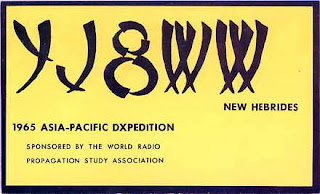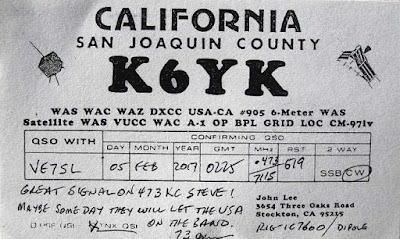Posts Tagged ‘CW’
 The Everlasting Ameco AC-1
The Everlasting Ameco AC-1
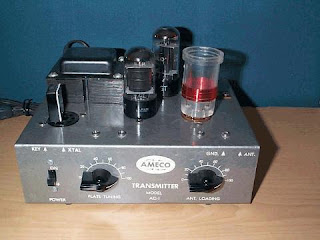 |
| courtesy: WB1GFH's AC-1 site |
I continue to be amazed at the high prices being paid on E-Bay for original Ameco AC-1 transmitters but perhaps I shouldn't ... they've been doing this for several years now.
Few radios that I can think of have elevated themselves to the cult status enjoyed by the AC-1, but the 3-tube Knight Ocean Hopper regen also comes to mind. Both radios typically reach $100- $200 on auction, with some going for much more. There were plenty of AC-1's sold and built over the years so it's not as if they're rare.
They seem to pop up frequently on E-Bay and the auctions are usually very spirited. I see a nice looking one at present, with 23 bids so far and now at $150! I guess the timing is just about right, with a large supply of now-retired ex-50's Novices who once owned an AC-1, looking to turn back the clock and recreate their early radio experience.
As transmitters go, they don't come much simpler, but the well-designed and smartly marketed radio made it extremely popular among the vast numbers of newly-licenced teenaged Novices who likely didn't have much spare change ... the first ones hit the market in the late 50's, right in time for the strongest solar cycle on record, selling for $14.95 in kit form. AC-1's continued to be sold into the early 70's with the price rising to around $25 ... a nice long run for most ham gear. I may be wrong but I don't think they were ever available in anything other than kit form.
Here is what the kit looked like upon arrival ... this one still NIB in 2012!
 |
| courtesy: http://www.wa0itp.com/ac-1.html |
There is also a large builder's interest in making AC-1 'clones' along with a dedicated Yahoo Group for additional support. Several years go I decided to scratch-build my own clone and found that I had everything needed except for the gray hammertone spray paint. Although most AC-1's used black chicken head knobs, some early models used maroon knobs so I decided to go with a red slide switch and red chicken head knobs on my reproduction. The important decal was available at the time from the Yahoo group but I see them now being sold by Radio Daze, for those that may want to try their hand at building a clone themselves.
The AC-1 uses the inexpensive 6V6 elevated from AF to RF duty, in a crystal-friendly Colpitts crystal oscillator. The only departure from the norm is the output circuit. Most inexpensive one-tubers end up with a link-coupled output but the AC-1 uses the more versatile pi-network ... something that no doubt added to its production costs but produced a transmitter able to load a wider range of antenna impedances while providing superior harmonic attenuation, both important in a beginner's rig.
My clone puts out 8 watts on 80m and 7 watts on 40m. Although never intended, doubling to 20m sees a large drop in efficiency, with output power dropping to 2 watts. Swapping to a 6L6 yields an extra couple of watts. Not enough to be noticed at the other end except when doubling or tripling.
I haven't had my clone on the air for a few years and think it's time to spark it up once again for some summertime fun on 40m CW. It would be great to work another clone or even a real AC-1 if you have one, but any contacts will be exciting if you would like to try.
I'll be hanging around 7118 kHz or down near 7040 and ... I won't be loud!
 The Don Miller Enigma
The Don Miller Enigma

A mention in the KE9V weekly 'CALLING CQ' e-mail letter brought back more memories of my teen DX years. The article pointed to a YouTube interview of legendary DXer Dr. Don Miller, W9WNV, conducted by another DX legend, Martti Laine, OH2BH. The fascinating interview was conducted in December 2016 and is broken into five parts.
For those old enough to remember, Don spent a few years in the late 60's providing DXers with one rare country after another ... dozens of them. He was a superb operator and the originator of the now ubiquitous "5NN" shortened signal report, after trying unsuccessfully with "FNN". He was also one of the very first to operate 'split', requiring stations to call up or down instead of the then prevalent one frequency pileup! Don was really instrumental in shaping much of what we see today as 'standard ops' when it comes to DX'pedition operations. To hear Don handle a pileup was something else. Often when the pile became very large, he would listen to the calling crowd for a couple of minutes and then respond with a list of calls and signal reports ... nothing like the individual exchanges we see today.
My little DX-20 and VF-1 were only able to work Don at one of his stops ... YJ8WW on 40m CW. He was all about giving the little guy, those running modest stations, an opportunity to work some rare countries.
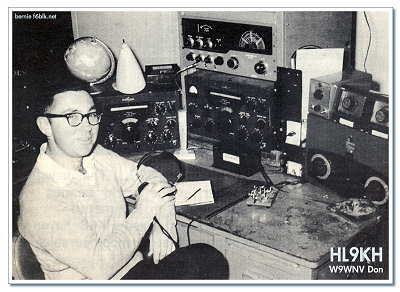 |
| courtesy: F6BLK |
As bad as things had become for Don, it got much worse, when in 1980, rightly or wrongly, he was convicted of conspiring to have his estranged wife killed and was sentenced to 25 years to life.
Don Miller is one of those 'larger than life' personalities whose presentations at DX clubs and conventions would bring the large crowds to their feet with his DX stories and expedition accomplishments.
The YouTube interviews show a somewhat contrite, remorseful man, compared to the one we met in the 60's but there's still a hint of that young mischief-maker and a twinkle in his 80 year old eyes as he teases of putting another rare one on-the-air, one last time.
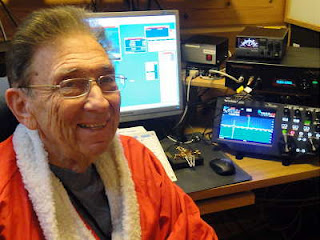 |
| courtesy: OH2BH |
[See also: "The Don Miller Story As Told By Hugh Cassidy, WA6AUD]
 The Don Miller Enigma
The Don Miller Enigma

A mention in the KE9V weekly 'CALLING CQ' e-mail letter brought back more memories of my teen DX years. The article pointed to a YouTube interview of legendary DXer Dr. Don Miller, W9WNV, conducted by another DX legend, Martti Laine, OH2BH. The fascinating interview was conducted in December 2016 and is broken into five parts.
For those old enough to remember, Don spent a few years in the late 60's providing DXers with one rare country after another ... dozens of them. He was a superb operator and the originator of the now ubiquitous "5NN" shortened signal report, after trying unsuccessfully with "FNN". He was also one of the very first to operate 'split', requiring stations to call up or down instead of the then prevalent one frequency pileup! Don was really instrumental in shaping much of what we see today as 'standard ops' when it comes to DX'pedition operations. To hear Don handle a pileup was something else. Often when the pile became very large, he would listen to the calling crowd for a couple of minutes and then respond with a list of calls and signal reports ... nothing like the individual exchanges we see today.
My little DX-20 and VF-1 were only able to work Don at one of his stops ... YJ8WW on 40m CW. He was all about giving the little guy, those running modest stations, an opportunity to work some rare countries.
 |
| courtesy: F6BLK |
As bad as things had become for Don, it got much worse, when in 1980, rightly or wrongly, he was convicted of conspiring to have his estranged wife killed and was sentenced to 25 years to life.
Don Miller is one of those 'larger than life' personalities whose presentations at DX clubs and conventions would bring the large crowds to their feet with his DX stories and expedition accomplishments.
The YouTube interviews show a somewhat contrite, remorseful man, compared to the one we met in the 60's but there's still a hint of that young mischief-maker and a twinkle in his 80 year old eyes as he teases of putting another rare one on-the-air, one last time.
 |
| courtesy: OH2BH |
[See also: "The Don Miller Story As Told By Hugh Cassidy, WA6AUD]
 LHS Episode #185: Second. Worst. Episode. Ever.
LHS Episode #185: Second. Worst. Episode. Ever.
 In the latest episode of Linux in the Ham Shack, which is in fact better than the title would suggest, we tackle a bunch of different and interesting topics. There's information on driving while hamming, openness at the FCC, Belarussian nanosats, open-source documentation, Firefox returning to Debian, Chinese Linux distributions, things Linux doesn't have that it should, CW clocks and more. Thank you for listening and please donate and share our Hamvention 2017 funding campaign. Thank you!
In the latest episode of Linux in the Ham Shack, which is in fact better than the title would suggest, we tackle a bunch of different and interesting topics. There's information on driving while hamming, openness at the FCC, Belarussian nanosats, open-source documentation, Firefox returning to Debian, Chinese Linux distributions, things Linux doesn't have that it should, CW clocks and more. Thank you for listening and please donate and share our Hamvention 2017 funding campaign. Thank you!
73 de The LHS Crew
 CQ Crossband and … 3 Down, 97 To Go!
CQ Crossband and … 3 Down, 97 To Go!
Several QSL cards have arrived after the last 630m 'crossband' event ... including one from ZF1EJ in the Cayman Islands confirming our 630m QSO in January.
The contact was made on JT-9, the 'WSPR QSO' mode, and represents DXCC country #3 for me on 630m ... only 97 more to go! ZF1EJ was running just 32 watts output when we had our 630m JT-9 contact but has since cranked his output to around 60 watts. Eden is beaconing most nights on WSPR and puts out a well-heard signal. He is very interested in two-way JT-9 work with other VE stations as well as any Europeans and down-under stations.
From what I can tell, it looks like JT-9 (similar to JT-65 but a much narrower bandwidth of 15.6Hz) is establishing itself as the go-to mode for weak signal two-way work on 630m. It has a couple of things going for it that makes it very attractive for this band ... it can dig way down into the noise (-25 db approximately) and communicate with very weak signals and, it does not require amateurs to know CW, a growing trend with newer operators and a real hindrance to two-way CW work. I suspect, and hope, that there will be much more CW activity on 630m once amateurs in the U.S.A. get the band as the amount of information that can be exchanged per transmission on JT-9 is limited ... time will tell.
In the meantime, here is a request for more two-way 'crossband' CW activity with amateurs in all parts of North America. I have recently totally revised the 'CQ Crossband' page on my website, 'The VE7SL Radio Notebook'. Please note that my web address for well over a decade, is no longer valid and everything has been moved to this new location. If you have the old one bookmarked or are linking to it from your own site, please be aware that previous links will now be dead.
The crossband concept allows amateurs not yet on 630m to still participate in this exciting part of the spectrum ... and to check out their ability to hear anything on MF. If we were to make a schedule for a crossband contact, I would be transmitting on 630m at full ERP while you would be answering on one of the HF bands ... usually 160, 80 or 40m.
I am very much interested in setting up crossband schedules for 630m at any time and can very likely enlist several other VE7s to be there as well so that you can work more than one station. I have full details on my updated 'CQ Crossband' web page but please do not hesitate to give crossband a try!
Roger, VE7VV in Victoria, B.C., recently became the 8th VE7 to muster RF on 630m, with power limited to 1 watt at present. Our contact was on CW while he worked stations in Vancouver on JT-9. Hopefully he will continue to build his station and become more active on the band.
Crossband continues to be a subject of much interest both here and with many U.S. stations that are waiting for the band. Recent cards from Colorado and California, shown below, are the latest to arrive.
K6YK gave me an RST of '519' but explained the reason for this was because he was receiving on his 3 el HF tri-bander which provided the best signal-to-noise value! This is often the case on 630m so try what you have. Many times a 'non-resonant' antenna will pick up less noise and yield the best signal readability.
If you would like to try a crossband QSO, please contact me at VE7SL (at) shaw.ca ... I'll keep the rig warmed up!
 CQ Crossband and … 3 Down, 97 To Go!
CQ Crossband and … 3 Down, 97 To Go!
Several QSL cards have arrived after the last 630m 'crossband' event ... including one from ZF1EJ in the Cayman Islands confirming our 630m QSO in January.
The contact was made on JT-9, the 'WSPR QSO' mode, and represents DXCC country #3 for me on 630m ... only 97 more to go! ZF1EJ was running just 32 watts output when we had our 630m JT-9 contact but has since cranked his output to around 60 watts. Eden is beaconing most nights on WSPR and puts out a well-heard signal. He is very interested in two-way JT-9 work with other VE stations as well as any Europeans and down-under stations.
From what I can tell, it looks like JT-9 (similar to JT-65 but a much narrower bandwidth of 15.6Hz) is establishing itself as the go-to mode for weak signal two-way work on 630m. It has a couple of things going for it that makes it very attractive for this band ... it can dig way down into the noise (-25 db approximately) and communicate with very weak signals and, it does not require amateurs to know CW, a growing trend with newer operators and a real hindrance to two-way CW work. I suspect, and hope, that there will be much more CW activity on 630m once amateurs in the U.S.A. get the band as the amount of information that can be exchanged per transmission on JT-9 is limited ... time will tell.
In the meantime, here is a request for more two-way 'crossband' CW activity with amateurs in all parts of North America. I have recently totally revised the 'CQ Crossband' page on my website, 'The VE7SL Radio Notebook'. Please note that my web address for well over a decade, is no longer valid and everything has been moved to this new location. If you have the old one bookmarked or are linking to it from your own site, please be aware that previous links will now be dead.
The crossband concept allows amateurs not yet on 630m to still participate in this exciting part of the spectrum ... and to check out their ability to hear anything on MF. If we were to make a schedule for a crossband contact, I would be transmitting on 630m at full ERP while you would be answering on one of the HF bands ... usually 160, 80 or 40m.
I am very much interested in setting up crossband schedules for 630m at any time and can very likely enlist several other VE7s to be there as well so that you can work more than one station. I have full details on my updated 'CQ Crossband' web page but please do not hesitate to give crossband a try!
Roger, VE7VV in Victoria, B.C., recently became the 8th VE7 to muster RF on 630m, with power limited to 1 watt at present. Our contact was on CW while he worked stations in Vancouver on JT-9. Hopefully he will continue to build his station and become more active on the band.
Crossband continues to be a subject of much interest both here and with many U.S. stations that are waiting for the band. Recent cards from Colorado and California, shown below, are the latest to arrive.
K6YK gave me an RST of '519' but explained the reason for this was because he was receiving on his 3 el HF tri-bander which provided the best signal-to-noise value! This is often the case on 630m so try what you have. Many times a 'non-resonant' antenna will pick up less noise and yield the best signal readability.
If you would like to try a crossband QSO, please contact me at VE7SL (at) shaw.ca ... I'll keep the rig warmed up!
 Novice Rig Round-Up Report
Novice Rig Round-Up Report

Last week's Novice Rig Round-Up delivered far more enjoyment than I ever imagined!
Operating from the left coast and choosing to limit my output power to 5 watts, I really didn't expect to work more than a half dozen stations or so. The week-long event included two weekends, providing plenty of opportunity for participants to spark-up their novice-class rigs or their favorite pre-80's 'boatanchors' ... and they did!
I had 68 contacts with other 'NRR' stations, working numerous Heathkits, Drakes, Johnsons and homebrewed favorites ... even a Collins KWS-1! Staying true to the 'novice' class spirit, most were using hand keys and a surprising number were even using crystal control.
I decided to enter the fray with my homebrew "Longfeller", shown above, run at 5W to take advantage of the low power multiplier as well as using crystal control.
After struggling to work two stations, I soon decided that if I was going to work much at all, I would need to switch to 'search and pounce' mode and use the VFO. The once ubiquitous Heathkit VF-1, with all of its charming quirks, was pressed into service. Although I've always loved its green hypnotic dial, a week with the VF-1 reminded me of all the things I also hated about it as a teenaged ham back in the mid 60s'. But as it did back then, it served me well and allowed me to park the Longfeller wherever I wanted.
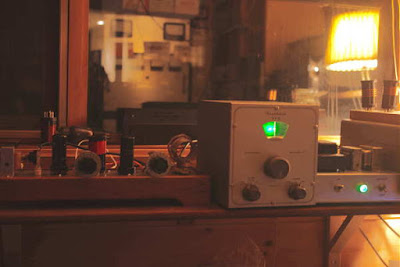 |
| My NRR Setup |
For the low bands (80/40m), the Longfeller was fed into full-sized vertical wire groundplanes made from homebrew ladder line and both fed with the same coaxial feedline.
A counterpoise of eight wire radials were laid on the lawn temporarily with the feedpoint sitting about 20' from the ocean. Being right at the ocean allows me to take advantage of an approximate 6db of "sea gain", effectively turning my 5 watts into 20 watts of radiated power. At times, my signal needed all the help it could get.
It was also exciting to catch the sometimes fleeting transcontinental openings on 15m, as the MUF often struggled to reach 21 MHz each morning. This very much reminded me of past solar cycle peak winters and the morning excitement of watching the MUF slowly climb towards 50MHz, or in some cases, shoot up like a rocket. As Cycle 24 reaches the bottom, the effects of low solar flux values on our higher bands becomes increasingly more evident. I suspect that there will be no 15m transcontinental work in next winter's NRR and who knows how long that might be the case. High MUFs were fun while they lasted ... another thing often taken for granted.
Without question, one of the most interesting parts of the nine day event was following the propagation variances from night to night on 40 and 80m. With a couple of exceptions, low-band propagation was generally pretty good, with one mid-week night being just great. Signals from the east coast to the southern states were strong and with almost no QSB. The Longfeller pushed its 80m signal to Florida, Maryland, New York, Alabama, Louisiana, Ohio and Kentucky. I remember many nights like this when operating 80m back in the early to mid 60's, during the lull between monster Cycle 19 and wimpy Cycle 20. Hopefully we will see more of these really nice transcontinental nights on 80 over the next several years.
For me however, the highlight of the event occurred last Saturday afternoon, while on 40m, fully ninety minutes before our local sunset. I had called WW6D after his 589 CQ only to hear him respond to another NRR local, Mark, CF7MM. He gave Mark's 50 watt DX-60 a '589' and when he finished I called him again ... with not even a whisper of response or even a QRZ. After I called him a third time, he returned to his CQ, leaving no doubt that he wasn't hearing a trace of my signal. Now full-sized 1/4 wave groundplanes mounted beside the ocean are not noted for producing high-angled radiation, which this path would certainly have benefited from, but I would have expected something!
I immediately moved down the band a few kilohertz and sent a short hand-keyed CQ and received an immediate response from WS1K in Plymouth, MA! Jon's signal was a solid and unwavering 559 and he was running only 5 watts as well ... and, he was crystal-controlled! The groundplane had swiftly redeemed itself as this exciting contact went into the log on 40m ... and all in broad daylight! Pictured below is Jon's transcon ether-busting machine ... proof that form does indeed follow function!
 |
| WS1K's 40m Transcon 6V6 Ether-Buster |
I'm really looking forward to next year's NRR but will definitely be running more power. I was impressed with the several Drake 2NT's that I heard and luckily enough, have one such rig in my boatanchor basement. It will be a good project to recap and put back on the air, along with the VF-1, which will also be given the once over to encourage it to behave properly when driving the classy Drake.
Please give the NRR some serious thought for next year ... it's not too early to start planning, refurbishing or to seek out and cherish that aging old beauty, presently hiding in someones attic gathering dust. See you in the NRR!

